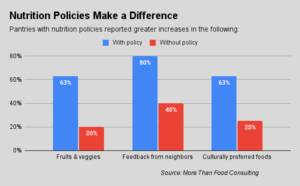The charitable food system — with its close connection to vulnerable populations — seems like the perfect environment to pursue strategies aimed at controlling diabetes. But finding those solutions is proving as complex as the disease itself.
Feeding America helped shed light on possible solutions when it completed a rigorous trial to test whether food pantries could help clients manage their diabetes. The upshot? It found that food pantries can play a critical role in supplying the type of healthy food needed to fight diabetes, but that broader support for diabetic clients is also needed.
“The charitable food system needs to be at the table,” said Dr. Hilary Seligman, senior medical advisor at Feeding America and an Associate Professor at the University of California San Francisco. “But it can’t be there alone.”
Managing diabetes, she noted, is extremely challenging and especially so for people who may not have access to regular medical care or healthy food. Not only do low-income and food-insecure people have a harder time managing diabetes, but they are more likely to develop it in the first place. One-third of households that receive assistance from food banks have at least one member with diabetes, according to Feeding America’s Hunger in America 2014 report.

Seeking to address this issue, Feeding America set up a trial involving three food banks and 568 participants split between two control groups. One group received food every two weeks that was specifically selected to address diabetes, as well as access to educational classes and resources related to diabetes. They could also get a referral to medical care if they did not have a primary care provider.
To measure the incidence of diabetes, this group also had their blood-sugar levels tested at enrollment and at three and six months by trained staffers and educators who work at the pantries. Members of the other group interacted with their food pantries just as they always had. At the end of six months, the two groups switched.
The survey found that the charitable food system helped improve food security for diabetic clients, and increased their intake of fruits and vegetables. Anecdotally, clients found it “extraordinarily valuable” to have pantries not only address their condition, but affirm how difficult it is to manage, Dr. Seligman said.
Other findings, however, were not as encouraging. “I had hoped we would be able to support people in lowering their blood sugar levels,” Dr. Seligman said. In addition, “I had hoped the charitable feeding system would be able to shoulder some of the burden” of providing diabetes-related care. The fact that the trial fell short of these goals, however, was not surprising, she said, given the challenges of managing this very complex disease.
Looking forward, the researchers would like to explore ways to more tightly integrate healthy food distribution with health care services, perhaps by establishing food pantries within health care clinics, Dr. Seligman said. Other related remedies include working toward resolving the root causes of hunger, say by enrolling more people in SNAP to ease pressure on food budgets and pave the way toward more healthy eating.
The Feeding America trial is not the only one to underscore the difficulties of utilizing food pantries to address diabetes care. A program in New Jersey, in which health care practitioners regularly visited food pantries to perform screenings, is also expected to fall short in moving the needle on blood-sugar levels, although education and awareness among clients has increased. Noted Dr. Seligman about the Feeding America trial, “It shows how challenging it is to do this work and how much of a deep investment it takes.”








